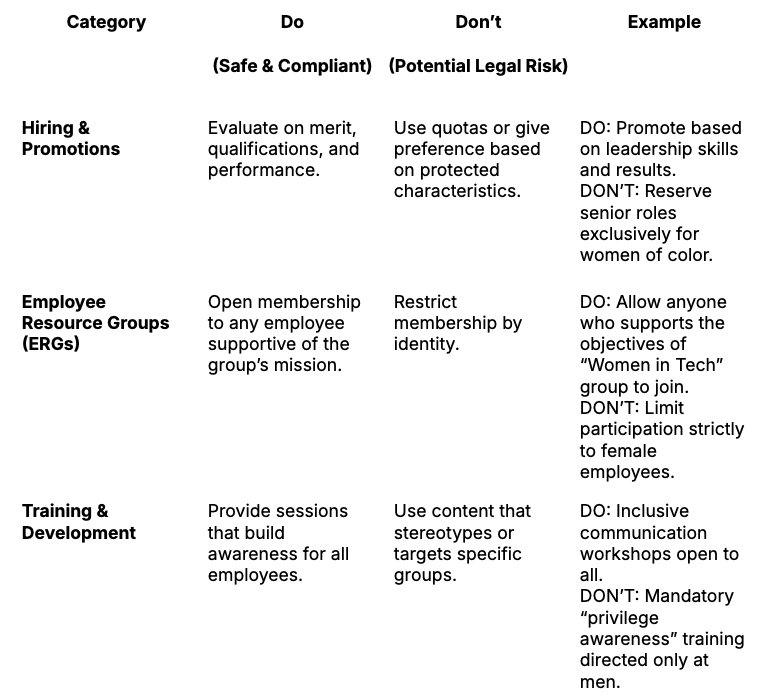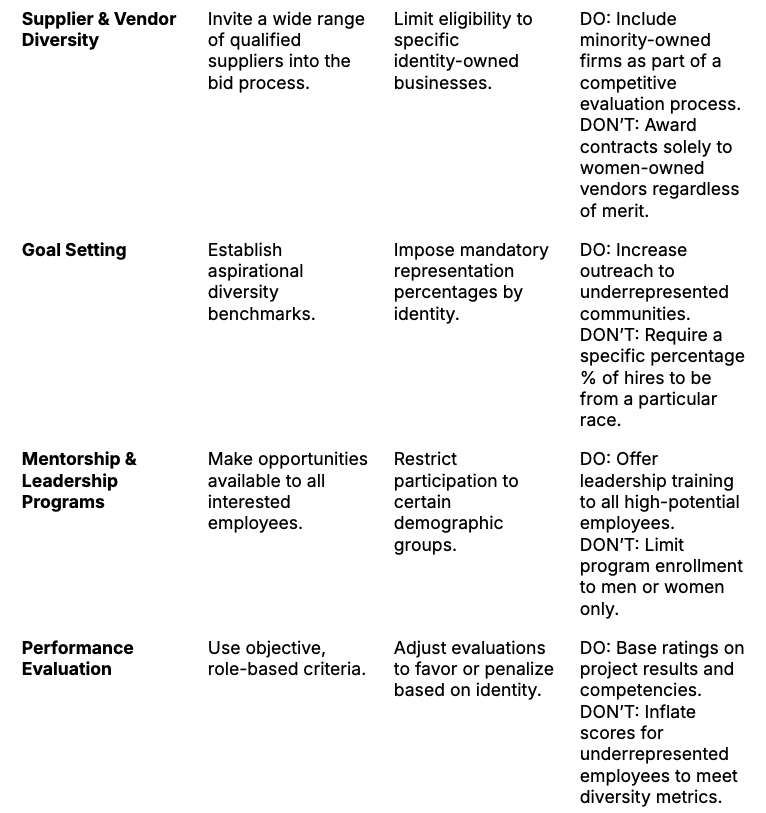Background
Diversity, Equity, and Inclusion (DEI) initiatives are vital to building workplaces where people of all backgrounds can thrive. Yet, as recent developments from the U.S. Department of Justice (DOJ) highlight, even well-intentioned programs can inadvertently cross into legally sensitive territory.
On July 29, 2025, the DOJ issued guidance clarifying how certain DEI strategies — particularly those implemented by organizations receiving federal funding — may violate federal anti-discrimination laws such as Titles VI, VII, and IX. While the guidance does not carry the force of law, it signals increased federal scrutiny and underscores the need for employers to ensure that DEI programs are firmly grounded in compliance.
To put things in perspective, the DEI programs we have been involved with which impact tens of thousands of employees across two dozen industries have always been fully compliant with existing laws. And Importantly, no laws have been changed. So despite what things may sound like, the executive orders, DOJ guidance, and similar directives are intended to strengthen the current laws and address a very small subset of programs that may have unintentionally gone too far—or in rare cases, been misused in ways that could create reverse bias. These cases represent the exception, not the rule, and should not discourage employers from building inclusive workplaces that meet both legal and business imperatives.
This blog post is intended as a simple roadmap to help employers think through the “Do’s and Don’ts” of DEI in light of recent developments. It is not a substitute for legal advice. Every organization’s situation is unique, and we encourage employers to consult their legal counsel for guidance on specific policies, practices, or risk considerations.
Potential Missteps to Keep in Mind
Most organizations approach DEI initiatives with care and a genuine commitment to doing the right thing. Still, on occasion, well-intentioned efforts can drift toward practices that raise legal or ethical concerns. While not common, these missteps can draw regulatory attention or weaken employee confidence. By being aware of the potential pitfalls outlined below, employers can confidently sustain DEI strategies that are both impactful and fully compliant.
Preferential Treatment Based on Protected Characteristics - Avoid reserving roles, opportunities, or resources for individuals of a particular race, gender, ethnicity, or other protected category.
Use of “Proxy” Criteria - Seemingly neutral criteria—such as targeting certain ZIP/Postal codes—can be unlawful if designed to favor or disadvantage a protected group.
Segregated or Exclusive Programs - Employee Resource Groups (ERGs), mentorship opportunities, and leadership tracks should not be restricted to certain identities.
Stereotyping in Training - Avoid language or frameworks in DEI programming that label entire demographic groups as inherently problematic, privileged, or deficient.
Principles of a Legally Sound DEI Strategy
To truly build sustainable, legally sound DEI programs, employers should ground their strategies in clear, positive principles. These principles ensure that inclusion efforts not only comply with the law but also strengthen organizational culture and performance. By focusing on fairness, transparency, and education, leaders can design DEI initiatives that foster trust, engagement, and long-term impact.
Anchor decisions in qualifications and performance - Selection and advancement should be based on skills, experience, and measurable contributions.
Ensure inclusivity in participation - Programs, ERGs, and events should welcome all interested employees.
Use aspirational rather than mandatory targets - While diversity goals are valuable, binding quotas tied to protected characteristics create legal risk.
Embed nondiscrimination commitments in policy and contracts - Formalize equal opportunity expectations in internal policies and supplier agreements.
Focus on education, not accusation - Training should encourage understanding and collaboration without alienating participants.
Quick Reference: Legal DEI Do’s and Don’ts
To make this easier in practice, the following quick-reference table distills the key principles into clear “Do’s” and “Don’ts.” This is not exhaustive, but it provides a straightforward guide for employers to quickly spot where their DEI initiatives may or may not align with best practices—and to address adjustments, where needed.




Strategic Steps for Employers
While understanding legal boundaries is essential, compliance alone won’t build a workplace where inclusion truly thrives. Employers need practical, forward-looking steps that both minimize legal risk and maximize cultural impact. The following strategies provide a starting point for aligning your DEI initiatives with business goals—ensuring they are inclusive, sustainable, and adaptable in a shifting legal environment.
Conduct Annual DEI Program Audits - Review recruitment, development, and engagement initiatives on a regular basis to ensure inclusivity and compliance are maintained as things evolve.
Reframe Goals Around Opportunity and Access - Emphasize widening access and support for all employees rather than guaranteeing outcomes based on identity.
Document and Communicate Policies Clearly - Ensure employees, managers, and external partners understand nondiscrimination standards and consequences for any policy violations.
Train Leaders on Compliant Inclusion - Equip managers and ERG leads with guidance on legally compliant DEI practices, and support them if they need further information or assistance.
Monitor Evolving Legal Guidance - Regulations and interpretations shift—stay informed and consult your DEI Advisor and your legal counsel when making program changes.
Final Takeaway
DEI efforts remain a powerful driver of innovation, employee engagement, and organizational resilience. The key is balancing intentional inclusion with legal compliance. By grounding initiatives in merit, maintaining open participation, and steering clear of identity-based mandates, employers can build diverse, equitable workplaces that withstand legal scrutiny.
When in doubt, think of DEI as broadening the table, not narrowing the guest list—and you’ll be in a strong position both culturally and legally.
For more blogs on related topics see here.
###
OurOffice helps busy HR and people leaders improve hiring, engagement, and retention by building a more inclusive workplace with an easy and affordable toolset, leading to better business outcomes. Unlike one-size-fits-all solutions, the OurOffice DEI platform is fully customizable to mix and match the right tools and ensure that you have the right solution to drive measurable impact.
Ready to take your DEI initiatives to the next level? Contact OurOffice today to learn how we can support your journey toward a more diverse, equitable, and inclusive workplace, or schedule a free session to discuss the challenges you are facing and get answers and guidance from professionals.




